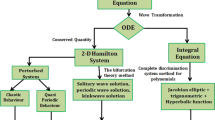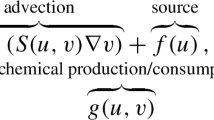Abstract.
Many excitable membrane systems display bursting oscillations, in which the membrane potential switches periodically between an active phase of rapid spiking and a silent phase of slow, quasi steady-state behavior. A burster is called parabolic when the spike frequency is lower both at the beginning and end of the active phase. We show that classes of voltage-gated conductance equations can be reduced to the mathematical mechanism previously analyzed by Ermentrout and Kopell in [7]. The reduction uses a series of coordinate changes and shows that the mechanism in [7] applies more generally than previously believed. The key hypothesis for the more general theory is that a certain slow periodic orbit must stay close to a curve of degenerate homoclinic points for the fast system, at least during the active phase. We do not require that the slow system have a periodic orbit when the voltage is held constant.
Similar content being viewed by others
Author information
Authors and Affiliations
Additional information
Received 28 March 1995; received in revised form 20 October 1995
Rights and permissions
About this article
Cite this article
Soto-Treviño, C., Kopell, N. & Watson, D. Parabolic bursting revisited. J Math Biol 35, 114–128 (1996). https://doi.org/10.1007/s002850050046
Issue Date:
DOI: https://doi.org/10.1007/s002850050046




